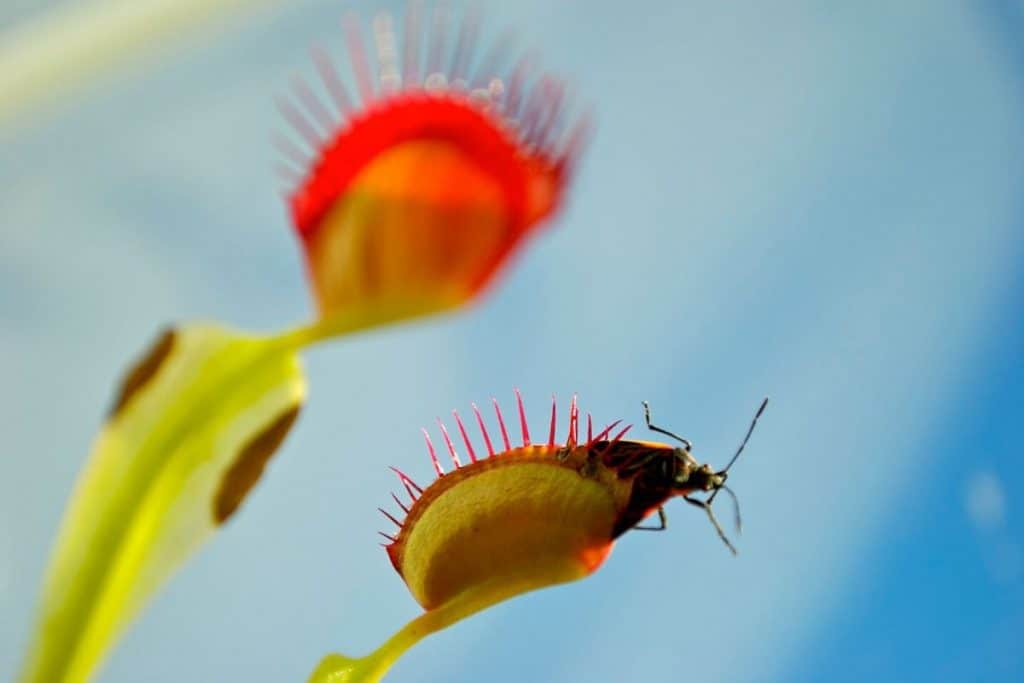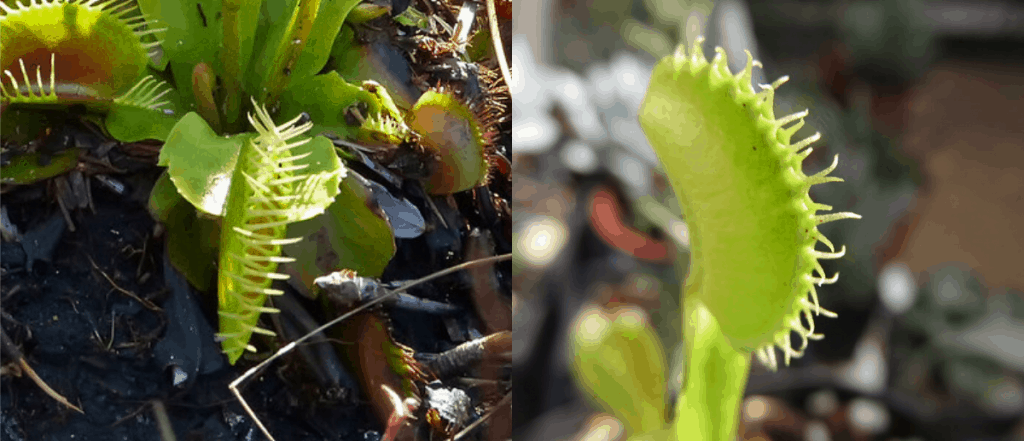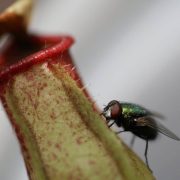
We all know that Venus Flytraps (Dionaea muscipula), love to eat all kinds of little insects. However, they are actually very picky about how they get fed, what they eat, and what they don't eat. So, how do you actually feed a Venus Flytrap?
The best way to feed your Venus Flytrap is by giving it living insects (not larger than about ⅓ of the snap trap), this way you are mimicking its natural habitat. You can also feed it dead insects but you have to trigger the little "hairs" in the trap by hand, otherwise, the Venus Flytrap won't accept the food.
The Venus Flytrap catches its own food, so it's not necessary to feed the plant. They get a lot of their energy from sunlight and water, but the food is a little bit extra for them.
CC features image By: Derek Gavey
Contents
- Feeding The Venus Flytrap Living Insects
- Feeding The Venus Flytrap Dead Insects (And Fooling The Snaptrap)
- Can You Feed Your Venus Flytrap Human Food?
- Best Foods For Your Venus Flytrap
- Can You Overfeed Your Venus Flytrap
- How Long Does It Take For The Flytrap To Digest Insects?
- How Long Can Venus Flytraps Go Without Food
- How Does The Trapping Mechanism Work?
Feeding The Venus Flytrap Living Insects
The best way to feed your Venus Flytrap is to give it live insects. Because this mimics the natural habitat of the Venus Flytrap, which the plant will be very satisfied with.
You can feed the plant by picking up a living insect with a pair of tweezers and putting it in the snaptrap. If the insect is not bigger than ⅓ of the trap and not too small that it can escape the trap, the trap will first close partially, detecting the insect in the trap. In this case, the trap will fully close after around 15 minutes of feeding.
To find the right living insects, you can look in your garden or anywhere else outside where there are small insects.
Feeding your snaptrap can be fun, but you don't want to overfeed your plant, more of that in a minute.
Feeding The Venus Flytrap Dead Insects (And Fooling The Snaptrap)
Another way to feed your Venus Flytrap is to feed it dead insects. The problem with this method is that the plant will detect that the insect is dead, and thus won't accept your gift.
The reason for this is because the chance that a dead fly will fall into a snaptrap of a Venus Flytrap, in his natural environment, is extremely unlikely. Therefore the plant will not accept the prey.
In order for the snaptrap to accept the prey, the small hairs inside of the trap need to bend multiple times, even when the trap has already closed.
But, there is a way you can feed your plant dead insects...
To mimic the movement of a living insect and fool the plant into thinking it has a living prey. You can give the dead insect in the snaptrap and wait for it to close. When it's closed, take a straightened paperclip for example en trigger the hairs a couple more times.
You can also, carefully, squeeze the snaptrap with your thumb and index finger, after it has closed. This way the hairs will get triggered and the plant will think it has caught a living prey.
Who would have ever thought you could fool a plant? This is great!
Can You Feed Your Venus Flytrap Human Food?
You are such a generous person, wanting to share your delicious supper with your carnivorous plant. But before you give your Venus Flytrap a piece of your hamburger or tofu, keep in mind that the food can actually harm the plant.
So, is it good to feed the plant with human food?
Feeding your Venus Flytrap human food is not good for the plant. The proteins that are in the food that we humans eat are different compared to the proteins that are in these insects. When you give your Venus Flytrap something different than insects, there is a big chance that it will not digest and will rot, which will kill the plant.
To conclude, don't feed your plant anything else besides insects.
Best Foods For Your Venus Flytrap
The best foods for the Venus Flytrap are living insects that are no bigger than ⅓ of the snaptrap and are not too small that they can escape the trap when it closes.
Actually, there are no "best" or "top 3" foods for the Venus Flytrap. It loves to eat insects, preferably living insects.
If you are not able to obtain living insects and you want to feed them nevertheless, you can buy freeze-dried bloodworms on Amazon, these bloodworms contain the perfect proteins for the plant. Your Venus Fly Trap will love these.
Can You Overfeed Your Venus Flytrap
There are numerous sources on the internet that say that overfeeding a Venus Flytrap is not possible. Although I wouldn't recommend feeding all the traps of a plant every week. You might overfeed it and it will die. The plant doesn't need to be fed every week with 20 insects to survive or grow strong.
So how often should you actually feed the Flytrap?
If you are keeping your Venus Flytrap in an outside environment, where it can catch its own insect, you don't have to feed it at all.
If you still want to feed the plant or if you are keeping the plant inside of your house – I would recommend feeding one whole plant with three insects a maximum of 5 times per year.
How Long Does It Take For The Flytrap To Digest Insects?
Now that you have followed the instructions in this blog post and you have given your Venus Flytrap a delicious insect to eat, it's time for the plant to digest the prey. The digesting process of the insect starts after 15 minutes of feeding when the trap of the Venus Flytrap fully closes.
Once the trap has been fully closed, the leave of the plant will secrete fluids into the trap that dissolve the soft parts of the prey, kill bacteria and fungi, and break down the insect with enzymes to take out the essential nutrients. These nutrients are then absorbed into the leaf. The digestion process will take up from five to 12 days, depending on the size of the bug and the health of the plant. After the digestion, the trap will reopen to release the exoskeleton of the prey.
How Long Can Venus Flytraps Go Without Food
Are you worried about your Venus Flytrap not catching enough insects to stay healthy and wondering how long the Dionaea muscipula can live without catching any prey?
Well, I was...
So, I did some research and found out that the average life span of a Venus Flytrap that doesn't catch (and digest) any insects is about 5 months. But this actually depends on how strong and healthy the plant is.
If the plant is weak and unhealthy, it will probably not survive for 5 months. But if the plant is strong, healthy, has the right soil, and gets enough sunlight, the plant could live for much longer than 5 months without catching any insects.
How Does The Trapping Mechanism Work?
Before we jump into the feeding part, we first are going to discuss a little bit about the trapping mechanism. The Venus Flytraps best grows outdoors where it can catch its own insects.
But how does a Venus Flytrap know if it has caught a fly, a raindrop, a small branch that fell out of a tree, or a finger?
Actually it's pretty simple; If you look closely at the snaptraps of a Venus Flytrap, you can see that it has little hairs on its traps. When an insect walks over these hairs, bending them multiple times, the snaptrap will be triggered and it will close (and catch the prey).
BUT... the snaptrap will not fully close yet. If the prey is small enough to crawl out of the trap, it wasn't worth digesting. If the prey can't escape, it will try to crawl out of the trap, bending the hairs inside the trap over and over.
The trap will detect the movement of the insect inside the trap, after which it will completely close. As you can see in the pictures below.
On the left photo, you can see that the hairs are triggers, and the snap has not fully closed yet. However, in the right photo, you can see that the plant has fully closed and is now going to digest its prey.



Leave a Reply